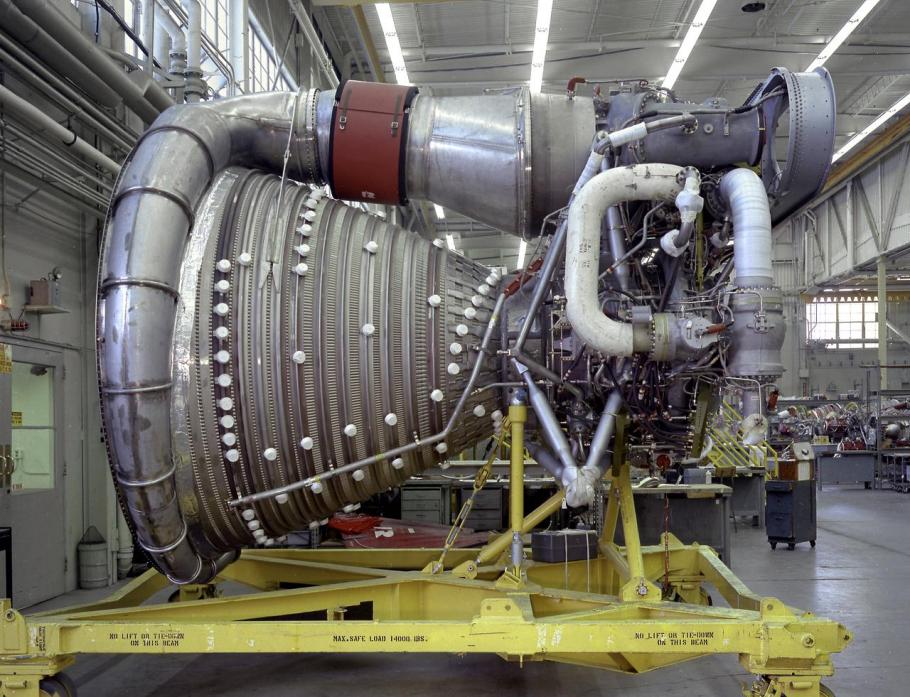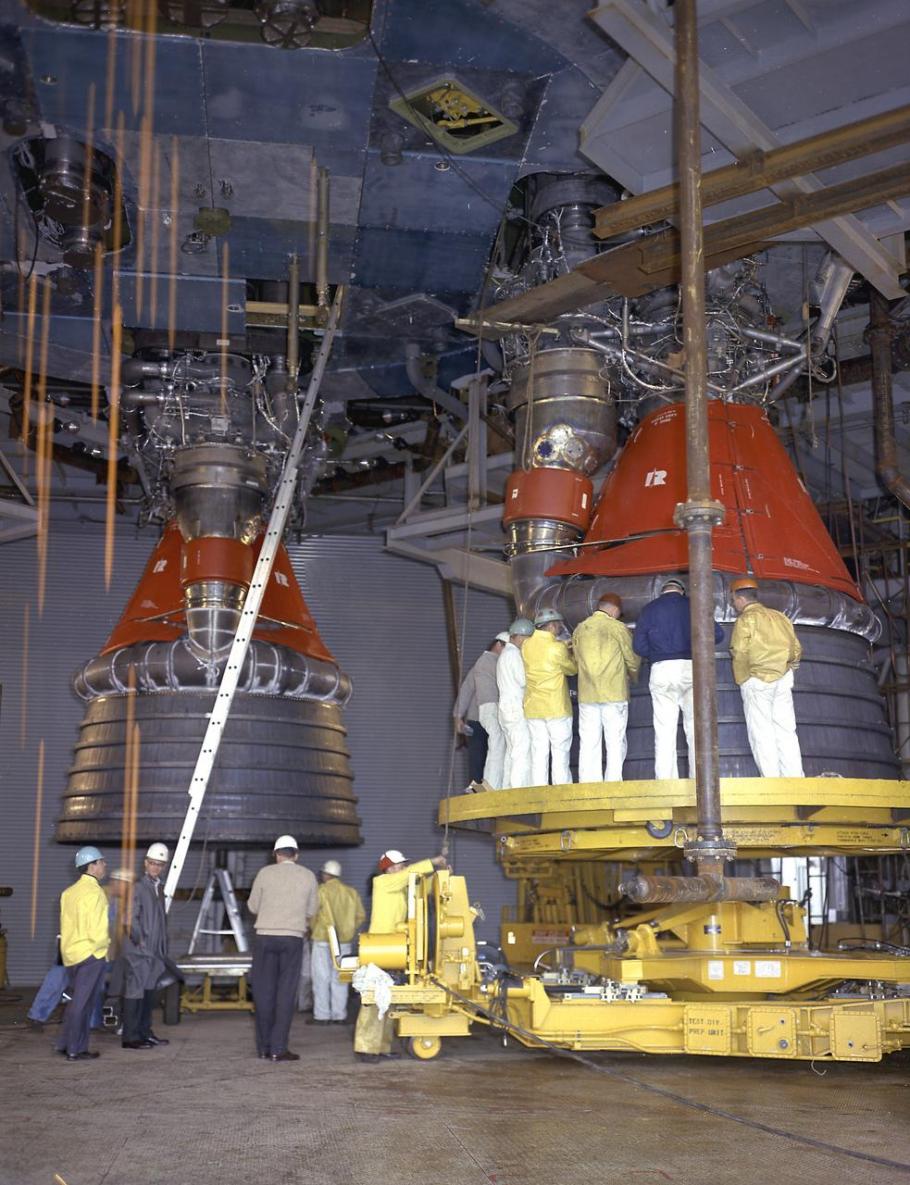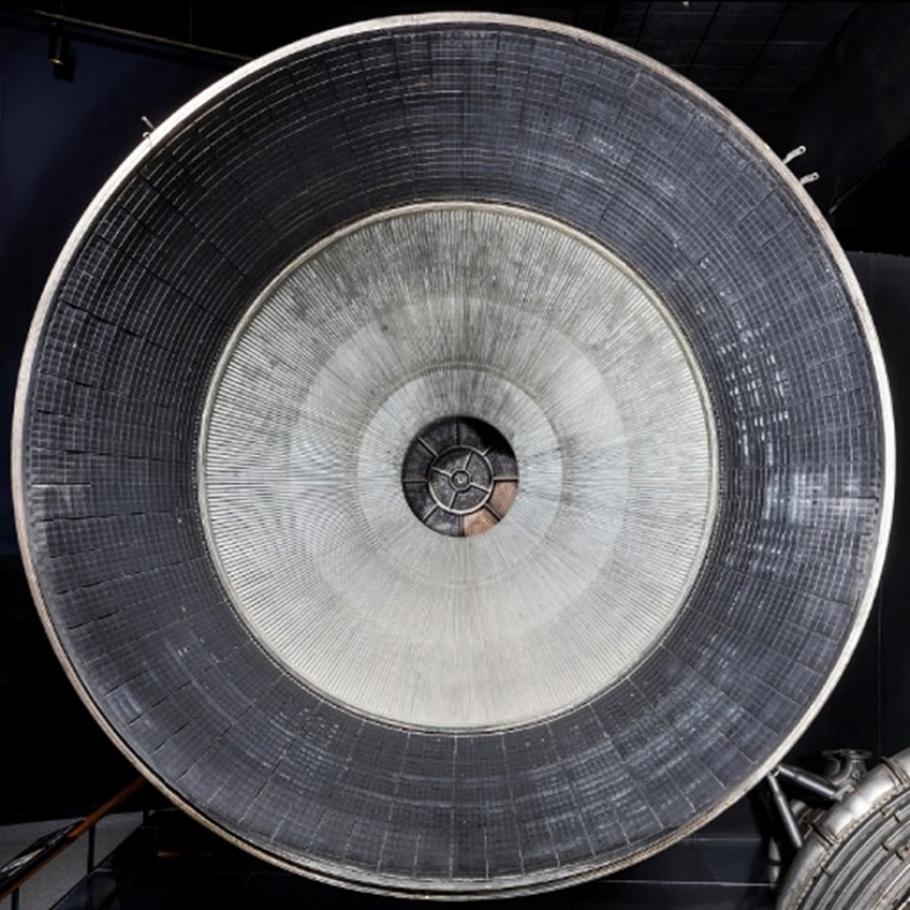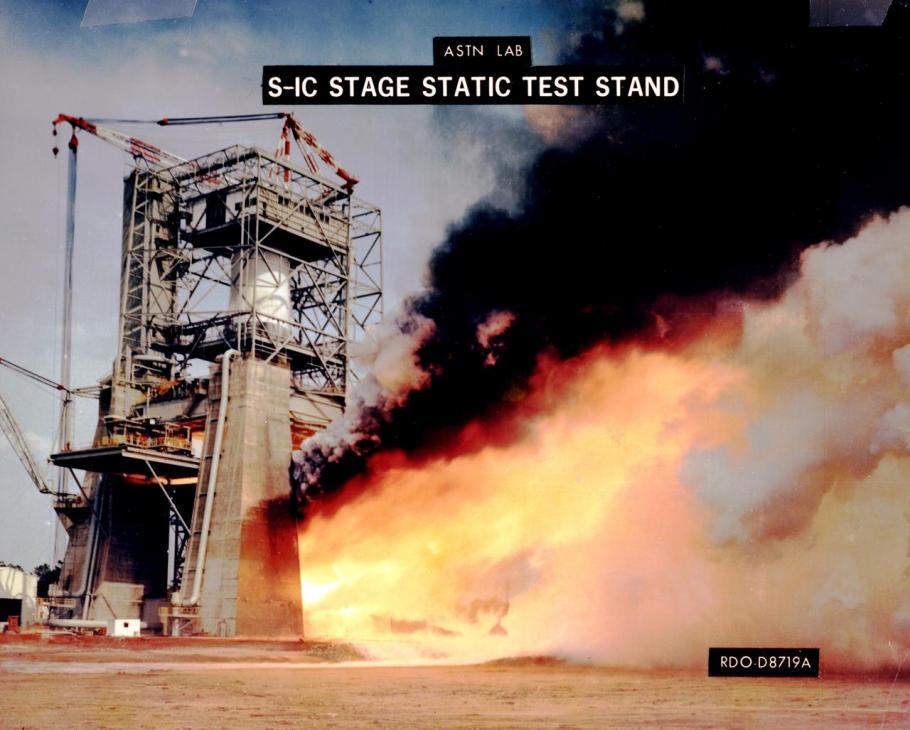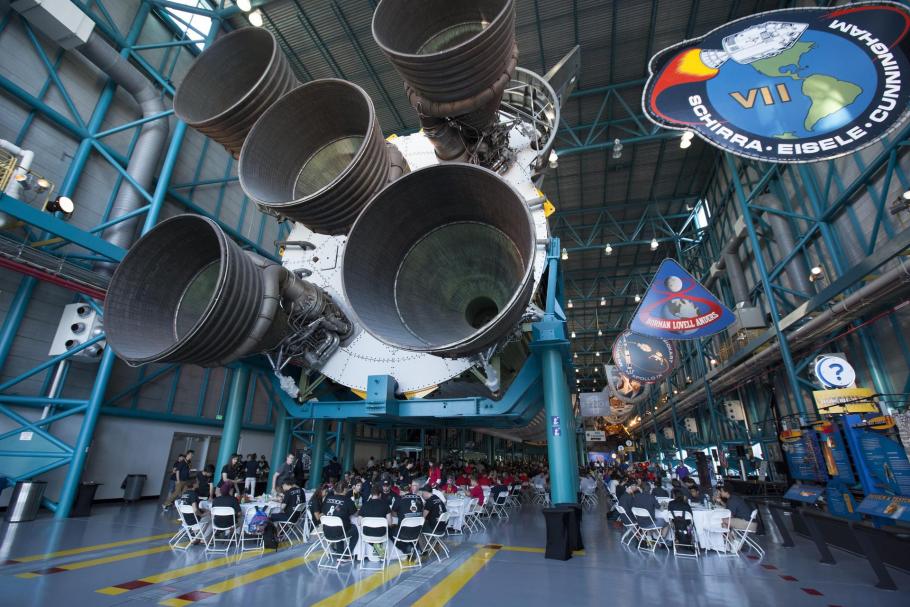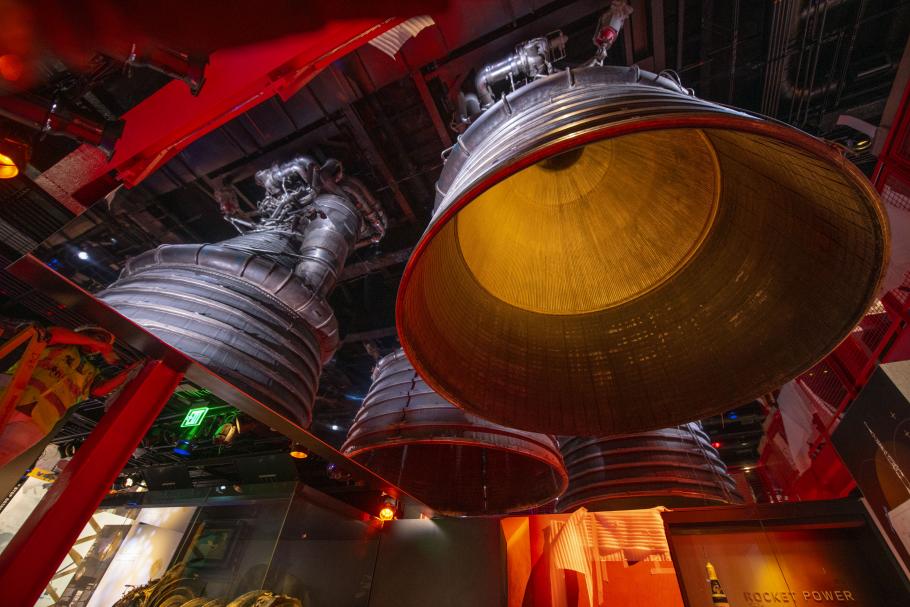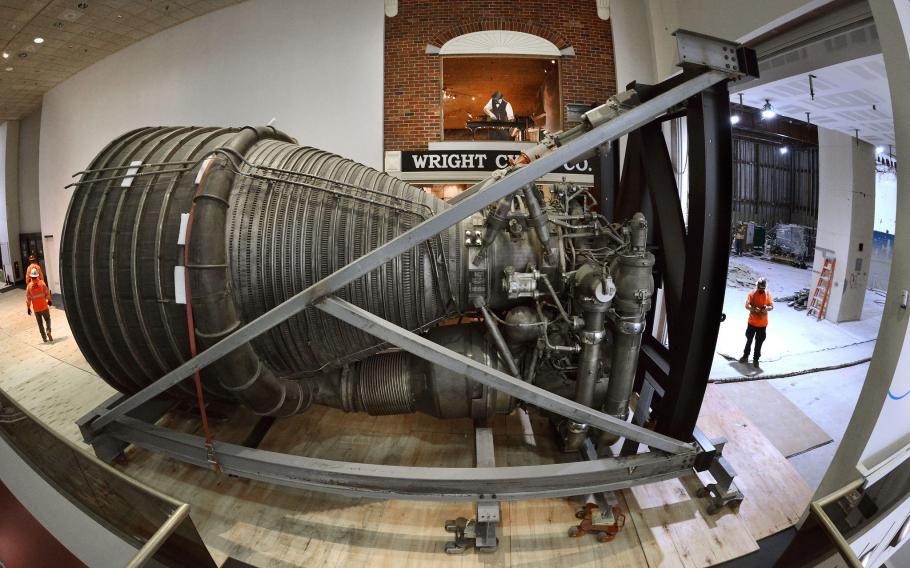The Saturn V rocket, the launch vehicle for the Apollo lunar missions in the 1960s and 1970s, remains the largest and heaviest rocket ever successfully launched. It stood 363 feet tall (taller than the Statue of Liberty) and weighed 6.2 million pounds when full of fuel. To get this massive rocket off the launch pad, into orbit, and on a trajectory for the Moon, the Saturn V needed some of the most powerful engines ever built. The powerhouse of the rocket’s first stage was the F-1 engine, developed and built by the Rocketdyne Division of North American Rockwell. A single F-1 engine could generate 1.5 million pounds of thrust—a potential energy output equivalent to about 17 Hoover Dams. The F-1 engine plays a central role in the history of rocketry, including the history of the Apollo program. The F-1 also plays a central role in the Museum’s new exhibition Destination Moon, which tells the history of the Apollo lunar missions within a wider political, social, and cultural context.
A completed F-1 engine from 1968. (Image courtesy of NASA)
The history of the F-1 engine begins before the establishment of the Apollo program. In fact, it begins even before the creation of NASA. The F-1 program started in 1955, when the U.S. Air Force contracted with Rocketdyne to build an engine that could have 1 million pounds of thrust, in the hope of using it to launch future satellites. Rocketdyne began working on a liquid-fuel engine that used refined kerosene (RP-1) and liquid oxygen (LOX) as propellants. In June 1958, the Air Force renewed the contract, with a new stipulation that the Rocketdyne engine be able to produce 1.5 million pounds of thrust.
With the launch of the Soviet Union’s satellite Sputnik in 1957 and the creation of NASA in October 1958, it soon became clear that the United States would need a launch vehicle that would be large enough to launch crewed and uncrewed missions into orbit—and perhaps even to the Moon. In January 1959, NASA contracted with Rocketdyne to continue developing the F-1. Work had to move quickly, given early Soviet successes in spaceflight. In 1961, Rocketdyne successfully fired a prototype of the engine.
Engineers installing F-1 engines on the static test stand at Marshall Space Flight Center. (Image courtesy of NASA)
The size and power of the F-1 created many engineering challenges. Engineers working at NASA, Rocketdyne, the Air Force, and American universities worked through the early and mid-1960s on resolving these issues. One problem was with combustion instability—pressure swings in the burning propellants that created hot spots and vibrations so strong they could destroy the engine. In 1961, this instability was so severe that it caused a test engine meltdown. Ultimately, engineers were able to solve the problem by adding baffles (copper dividers) to the injector plate that fed the propellant into the combustion chamber.
Looking into the F-1 nozzle, the injector plate (with holes to inject propellants and added baffles for combustion stabilization) is visible in the center. (Smithsonian Institution)
The Saturn V used five F-1 engines for the first stage, giving a total thrust of 7.5 million pounds. The engines were arranged with a fixed center engine surrounded by four outboard engines that could gimbal (swivel) for steering. During a launch, the F-1s on the first stage burned for just over two and a half minutes. Traveling at 6,000 miles per hour, the first stage lifted the rocket roughly 40 miles above the launch pad. When its fuel was spent, the first stage released, landing in the Atlantic Ocean. The second and third stages (with Rocketdyne J-2 liquid-hydrogen/LOX engines) then provided the force needed to get into orbit and subsequently put the spacecraft on a trajectory to the Moon.
Test firing of all five F-1 engines at Marshall Space Flight Center. (Image courtesy of NASA)
The Saturn V rocket was first tested in November 1967 and launched the crewed Apollo 8 mission to lunar orbit in December 1968. Apollo 11 launched on a Saturn V in July 1969. Throughout the remaining six Apollo launches and the later launch of the American space station Skylab, the F-1 engines never failed in flight.
Array of five F-1 engines on a Saturn V. (Image courtesy of NASA)
The new Destination Moon exhibition, tells stories of lunar missions within their wider historical contexts. The Rocketdyne F-1 engine is central to telling these stories and the safe preservation and display of the F-1 engine in Destination Moon is made possible by a $1 million gift from the Aerojet Rocketdyne Foundation.
The new exhibition takes an earlier display of one and a quarter F-1 engines from the old Apollo to the Moon gallery and lifts this arrangement vertically. When combined with mirrors, the installation gives the illusion of all five F-1 engines. This arrangement offers a new perspective on the engine. Now, visitors can stand underneath the array of F-1 engines, seeing how they would have appeared looming over the flame trench prior to launch. On a new mezzanine level, it is also possible to see the engine’s exterior up close.
Installing the Museum’s F-1 test engine in the new Destination Moon gallery. (Smithsonian Institution)
Because the F-1 engines (along with the entire first stage) were jettisoned into the Atlantic shortly after launch, the engines in the Museum’s display are not ones used on an Apollo launch. Instead, the center engine is an early test engine, built in 1963, at the time when engineers were working on the issue of combustion instability. This engine made four start tests, burning for a total of 192.6 seconds, which was longer than the time the F-1 was fired during an actual launch. Rocketdyne donated this test engine to the Museum in 1970. It was first displayed when the National Mall building opened in 1976.
Nearby, it is possible to see parts from an F-1 engine that did launch. Pieces from an Apollo 11 F-1 engine (recovered by Bezos Expeditions from the floor of the Atlantic Ocean) provide a closer view of many of the engine’s components, including the injector plate that Rocketdyne engineers dedicated so much attention to optimizing in the 1960s.
Carefully moving the Rocketdyne F-1 test engine on the Museum floor to its new gallery. (Smithsonian Institution)
The F-1 engine remains an important part of the story of spaceflight in the United States and of the Apollo program. The new Destination Moon gallery gives visitors a new perspective on this powerful engine.
